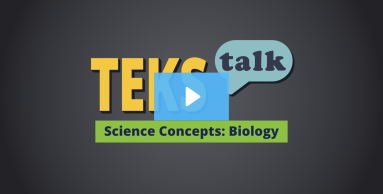
Knowledge and Skills Statement
The further explanation is designed to be a resource for educators that helps them better understand the topic their students are learning. Further explanations may be written at a more complex level than would be expected for students at the grade level.
Meiosis occurs in two stages. In humans, a gametic cell has 46 chromosomes. Just before meiosis I begins, the DNA in the gametic cell replicates, making 46 pairs of chromosomes.
During meiosis I, several significant events occur which increase genetic variation. The first occurs during prophase I. During prophase I, each pair of homologous chromosomes lines up and exchanges genetic information in a process called crossing over. During metaphase I, a process known as independent assortment occurs, during which the homologous pairs of chromosomes line up randomly at the equator of the cell. Then the gametic cell divides, producing two diploid daughter cells with 23 pairs of chromosomes in each. This is known as chromosome reduction.
During meiosis II, the two daughter cells each divide again, producing four haploid daughter cells (eggs and sperm) with 23 chromosomes each.
Each of these processes increases genetic variation of egg and sperm cells, which increases variation in the characteristics of the offspring of the parent organisms.
Research
Serrano-León, I. M., P. Prieto. and M. Aguilar "Correction: Telomere and Subtelomere High Polymorphism Might Contribute to the Specificity of Homologous Recognition and Pairing During Meiosis in Barley in the Context of Breeding." BMC Genomics 24, no. 642 (2023): https://doi.org/10.1186/s12864-023-09738-y
Summary: We already have an extensive knowledge on different stages of the meiosis, the cell division to generate the gametes in species with sexual reproduction, such as the formation of the synaptonemal complex, recombination, and chromosome segregation. But meiosis really starts with the identification of homologous chromosomes and pairing initiation, and it is still unclear how chromosomes exactly choose a partner to appropriately pair for additional recombination and segregation. The molecular basis for the specificity of homologous recognition and pairing occurring in the early chromosomal interactions at the start of meiosis in barley may be provided by the studied polymorphisms.
Research
Gioia, Michael, Michael Gioia, Lisette Payer, Sagar Salim, Ghanim Fajish V., Amamah F. Farnaz, Gianno Pannafino, Jun Jie Chen,V. P. Ajith, Sherikat Momoh, Michelle Scotland, Vandana Raghavan, Carol M. Manhart, Akira Shinohara, K. T. Nishant, and Eric Alani. "Exo1 Protects DNA Nicks from Ligation to Promote Crossover Formation During Meiosis." PLoS Biology 21, no. 4 (April 2023): e3002085. https://doi.org/10.1371/journal.pbio.3002085
Summary: In most sexually reproducing organisms, crossing over between chromosome homologs during meiosis is essential to produce haploid gametes. Here, we provide genetic evidence in baker's yeast that Exo1 promotes meiotic crossing over by protecting DNA nicks from ligation. These studies provide experimental evidence for Exo1-protected nicks being critical for the formation of meiotic crossovers and their distribution.
